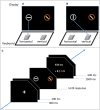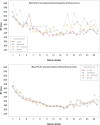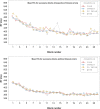Value Associations Modulate Visual Attention and Response Selection
- PMID: 34093346
- PMCID: PMC8175643
- DOI: 10.3389/fpsyg.2021.656185
Value Associations Modulate Visual Attention and Response Selection
Abstract
Every day, we are confronted with a vast amount of information that all competes for our attention. Some of this information might be associated with rewards (e.g., gambling) or losses (e.g., insurances). To what extent such information, even if irrelevant for our current task, not only attracts attention but also affects our actions is still a topic under examination. To address this issue, we applied a new experimental paradigm that combines visual search and a spatial compatibility task. Although colored stimuli did not modulate the spatial compatibility effect more than gray stimuli, we found clear evidence that reward and loss associations attenuated this effect, presumably by affecting attention and response selection. Moreover, there are hints that differences in these associations are also reflected in a modulation of the spatial compatibility effect. We discuss theoretical implications of our results with respect to the influences of color, reward, and loss association on selective attention and response selection.
Keywords: Simon task; associative learning; attention; monetary loss; monetary reward; response selection.
Copyright © 2021 Walle, Hübner and Druey.
Conflict of interest statement
The authors declare that the research was conducted in the absence of any commercial or financial relationships that could be construed as a potential conflict of interest.
Figures





Similar articles
-
Previously Reward-Associated Stimuli Capture Spatial Attention in the Absence of Changes in the Corresponding Sensory Representations as Measured with MEG.J Neurosci. 2020 Jun 24;40(26):5033-5050. doi: 10.1523/JNEUROSCI.1172-19.2020. Epub 2020 May 4. J Neurosci. 2020. PMID: 32366722 Free PMC article.
-
Reward- and attention-related biasing of sensory selection in visual cortex.J Cogn Neurosci. 2014 May;26(5):1049-65. doi: 10.1162/jocn_a_00539. Epub 2013 Dec 17. J Cogn Neurosci. 2014. PMID: 24345176 Clinical Trial.
-
Irrelevant reward and selection histories have different influences on task-relevant attentional selection.Atten Percept Psychophys. 2015 Jul;77(5):1515-28. doi: 10.3758/s13414-015-0851-3. Atten Percept Psychophys. 2015. PMID: 25813737 Clinical Trial.
-
How Does Awareness Modulate Goal-Directed and Stimulus-Driven Shifts of Attention Triggered by Value Learning?PLoS One. 2016 Aug 2;11(8):e0160469. doi: 10.1371/journal.pone.0160469. eCollection 2016. PLoS One. 2016. PMID: 27483371 Free PMC article.
-
Rewards teach visual selective attention.Vision Res. 2013 Jun 7;85:58-72. doi: 10.1016/j.visres.2012.12.005. Epub 2012 Dec 19. Vision Res. 2013. PMID: 23262054 Review.
Cited by
-
A Smarter Pavlovian Dog with Optically Modulated Associative Learning in an Organic Ferroelectric Neuromem.Research (Wash D C). 2021 Dec 20;2021:9820502. doi: 10.34133/2021/9820502. eCollection 2021. Research (Wash D C). 2021. PMID: 35024616 Free PMC article.
-
Learned cognitive control counteracts value-driven attentional capture.Psychol Res. 2023 Oct;87(7):2048-2067. doi: 10.1007/s00426-023-01792-1. Epub 2023 Feb 10. Psychol Res. 2023. PMID: 36763140
References
-
- Allport A. (1989). “Visual attention,” in Foundations of Cognitive Science, ed. Posner M. I. (Cambridge, MA: MIT Press; ), 631–682.
LinkOut - more resources
Full Text Sources

